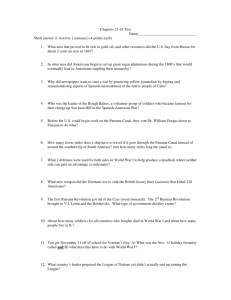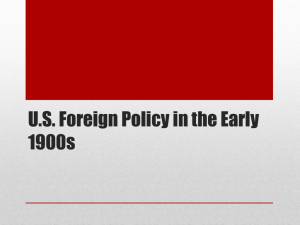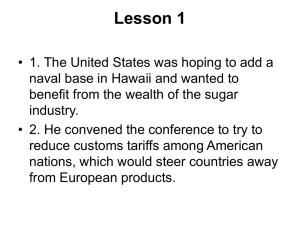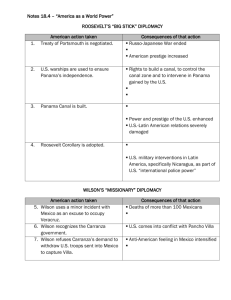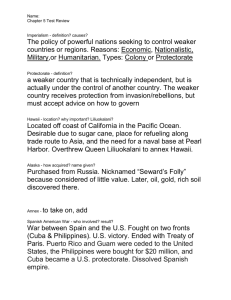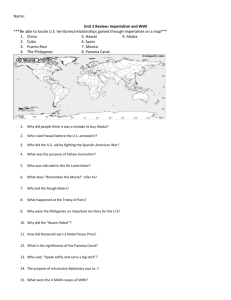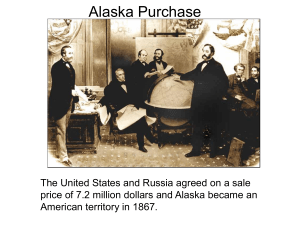United States Imperialism: The Panama Canal and Hawaii
advertisement
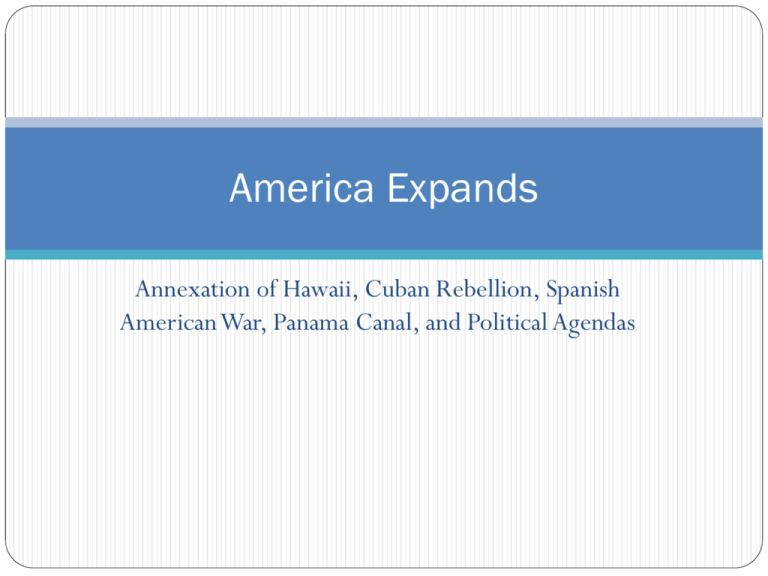
America Expands Annexation of Hawaii, Cuban Rebellion, Spanish American War, Panama Canal, and Political Agendas Territorial Expansion Alaska Added U.S. buys Alaska from Russia for $7.2 million! Less than 2 cents an acre . . . Got 600,000 acres! Annexation of Hawaii 1870, Americans in Hawaii controlled most land and trade 1886, U.S. allows Hawaii to ship sugar to U.S. tariff free in exchange for Pearl Harbor. Who would oppose tariff-free sugar? 1890, McKinley Tariff Hawaii now has to pay tariffs Leads to economic crisis in HI Why? Annexation of Hawaii cont. Read the last 2 paragraphs on page 494. What happened in 1891? 1893? 1898? Spanish-American War Watch the film and answer the questions about the Spanish- American War. The Panama Canal The Panama Canal November 1903 U.S. had tried to negotiate with Colombia about the construction of the canal U.S. supported Panama in her quest for independence from Colombia . . . IF the U.S. was granted “unending” control over a ten-mile wide strip of land in Panama . . . To build the Panama Canal Why would the U.S. want this land? The Panama Canal It took: 10 years to build 40,000 + workers 390 million $$$ It is approximately 50 miles long Theodore Roosevelt’s Role Responsible for negotiating the treaty Part of his Roosevelt Corollary Some believed he was trying to dominate Latin America. Panama Canal Statistics Took 5,609 lives due to accidents and disease, mostly Caribbean laborers. 13,000 vessels pass through yearly. 70% come from U.S. Ports. Average voyage takes 8 days to cover entire canal. Convenient Waterway War materials and thousands of troops passed through the canal during WWII, Korean War, and the Vietnam War. More Canal History U.S. turns over control to Panama in 1999. Cuba America as a World Power “The world becomes smaller” Turn to the person beside you and explain what this means. Also discuss HOW and WHY the world becomes smaller. Spheres of Influence European countries had carved out “spheres of influence” in China SoI = Areas where an imperial country has exclusive trading rights The U.S. fears missing out on this. Why? Need access to important foreign market for American products So what does the U.S. do? Open Door Policy Secretary of State, John Hay, saw the need to open trade for the U.S. in China Proposes in 1899 the “Open Door Policy” Called for equal trading rights in China for all countries No countries actually responded to his proposal, so he just declared that it was approved. In this cartoon, Uncle Sam restrains the militaristic aggression of the European Great Powers—France, Russia, Germany, and Italy—while China desirously eyes an American-made train engine, sewing machine, and other U.S. commercial products. In the left-background, Britain’s John Bull doffs his hat approvingly at Uncle Sam’s behavior. The only major player missing from the scene is Japan, whose emergence as a Great Power and intervention in China following the Sino-Japanese War of 18941895 was key to spurring other nations to compete for economic and political influence there. http://www.tobacco.harpweek.com/09Cartoon/BrowseByDateCa rtoon.asp?Month=November&Date=18 A Fair Field and No Favor! Uncle Sam, “I’m out for commerce, not conquest!” Dollar Diplomacy To discourage European affairs in Latin America, President Taft established in 1912, “Dollar Diplomacy” Encouraged American banks and businesses to invest in L.A. countries to discourage their reliance on Europe. Taft promised that the U.S. would step in if unrest threatened these investments. What doctrine does the idea of “dollar diplomacy” come from? Roosevelt Corollary Added to the Monroe Doctrine M.D. – warned not to establish new colonies R.C. – U.S. would intervene, with force if necessary, in L.A. nations to prevent European interventions. Global Economy Growth in international trade at the turn of the century contributed to a “global economy.” What’s another word for this? Globalization Review Go back and find the 6 bolded AND italicized words on your worksheet and write a 12-word definition for each. They look like this: Bolded AND Italicized

